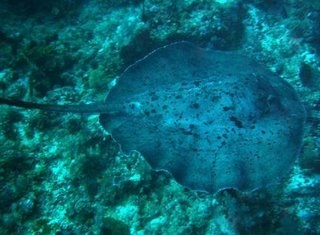Revenge Theory in Stingray Attacks
 At least 10 stingrays have been found dead and mutilated on Australia's eastern coast since "Crocodile Hunter" Steve Irwin was killed by one of the animals last week, an official said Tuesday, prompting concerns of revenge attacks on the normally docile fish.
At least 10 stingrays have been found dead and mutilated on Australia's eastern coast since "Crocodile Hunter" Steve Irwin was killed by one of the animals last week, an official said Tuesday, prompting concerns of revenge attacks on the normally docile fish.The popular television star was killed last week when a stingray barb pierced his chest as he filmed a TV show off Australia's Great Barrier Reef, prompting an outpouring of grief in Australia and among his fans worldwide.
The dead stingrays have been discovered on two beaches in Queensland state, including two that were found Tuesday with their tails lopped off, state fisheries department official Wayne Sumpton said.
Sumpton said fishermen who inadvertently catch the diamond-shaped rays sometimes cut off their tails to avoid being stung, but the practice is uncommon.
Michael Hornby, the executive director of Irwin's conservation group Wildlife Warriors, said he was concerned the rays were being hunted and killed in retaliation for the TV star's death.
"It may be some sort of retribution, or it may be fear from certain individuals, or it just may be yet another callous act toward wildlife," he said.
He said killing stingrays was "not what Steve was about."
"We are disgusted and disappointed that people would take this sort of action to hurt wildlife," he said.
Stingrays are usually shy, unobtrusive fish that rummage along the sea bottom for food or burrow into the sand. When stepped on or otherwise frightened, a serrated spine up to 25 centimeters (10 inches) long in the animal's tail flares up.
The spines emit toxins that can kill small creatures and cause excruciating pain in humans. Few people die from the poison, but the spines can badly tear flesh and the wounds are prone to infections, including tetanus.
Hornby said people should treat stingrays with caution, but "there is still no need to ... kill or mutilate these important animals."
Source: www.cnn.com



















0 Comments:
Post a Comment
<< Home